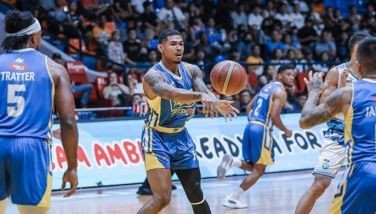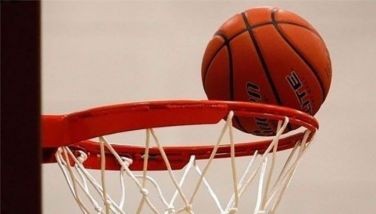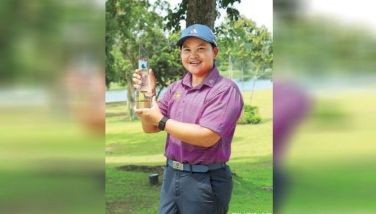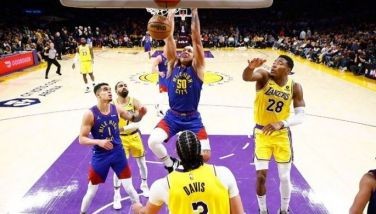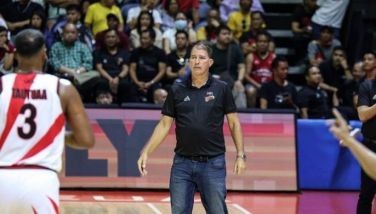A bridge too far

There were high hopes for the Philippine contract bridge team of nine men and three women to bag at least a medal in four of the six events in the Asian Games calendar in Indonesia but alas, the card players returned home with nothing to show except the experience of learning how to be better prepared for a competition of this magnitude.
The Philippine bridge squad was made up of the Asian Games’ oldest participant Kong Te Yang, 85, Viksi Egan, 74, Romulo Virola, 71, Dr. Allen Tan, 71, Gemma Mariano-Tan, 64, Alberto Quiogue, 61, Gerry Alquiros, 60, Dr. George Soo, 59, Joseph Maliwat, 39, Eleazar Cabanilla, 39, Andrew Falcon, 36 and Ann de Guzman, 33.
There were four events where the Philippines competed. In men’s pair, Quiogue and Maliwat took 19th of 33 and made the cutoff of 24 for the semifinals. Two other Filipino teams weren’t as lucky. Tan and Soo finished No. 31 and Falcon and Cabanilla, No. 32. In the semifinals, Quiogue and Maliwat wound up No. 22 and missed the cutoff of 12 for the final.
In men’s team, the Philippines landed eighth of 14 and did not advance to the semifinals where only the top four played. In the qualifications of mixed pairs, De Guzman and Virola ranked No. 4 of 27 but Alquiros and Mariano-Tan landed No. 23 and Egan and Yang did not finish. Egan and Yang, the Philippines’ oldest players, were too tired to continue after two days of competition and since they had no replacement, decided to quit. The top 16 moved to the semifinals where De Guzman and Virola were eliminated after ending up No. 16 with the cutoff of 12 for the final. In the supermixed team, the Philippines was represented by De Guzman, Egan, Tan, Soo, Alquiros and Mariano-Tan. The squad beat only Malaysia and finished No. 9 of 10 in the qualifications. The top four advanced to the semifinals. Seven countries earned medals from bridge with China topping the list, pocketing three golds, a silver and two bronzes. Chinese-Taipei, India and Singapore also took golds. Hong Kong, Thailand and Indonesia were others that made it to the medal standings.
Mariano-Tan said De Guzman and Virola had the most success in mixed pairs. “Not surprisingly because Virola is a very talented player and probably has the best mind with a PhD in statistics from Michigan,” she said. “De Guzman is a very aggressive player, always a plus where other women are involved. Why, after they shone in the qualifications, they did so miserably in the semifinals? In the second session, they were riddled by bad luck to add to bad decisions. Perhaps, having the field limited to the best of the best had something to do with it.”
In men’s pairs, Mariano-Tan said Quiogue and Maliwat expectedly advanced to the semifinals. “Quiogue has been playing since he was eight, sitting on a biscuit can to reach the table,” she said. “He is now 61 and one of the top five players alive today. Maliwat was a youth player 15-20 years ago. Both don’t have the means to attend international competitions but Quiogue, being older and known longer for his expertise, has been supported by his partners to afford these trips. Our supermixed team was a total fiasco. We only won our first match against Malaysia, the weakest team. The issues all lead to a lack of practice. With more chance of playing with each other, a better understanding could have been worked out. Why couldn’t they practice? Allen lives in Singapore, the other two here. As for the women, what deeply affected us was Egan had not planned on playing so she flew almost directly from the US to Jakarta, arriving on the 21st and expected to play the next day.
“Why this lack of planning? Because as of February, we no longer had a supermixed team. Another group had decided to form a mixed team. To get out of it, Egan accepted an invitation from her sons to celebrate her 75th birthday on an Alaskan cruise. I was ready to sit out the Asian Games and we were unsure of PSC or POC backing anyway. Then the backing came for one team. The PSC wanted three of the 2011 gold medalists on the team. One thing that affected our performance was lack of players. We have perhaps 70 bridge players, 15 competent enough to be sent to international competitions. We have maybe eight youth players who are far from ready. The rest are players in their 70s, 80s and 90s. It’s a very sad state of affairs.
“There are really very few sports like bridge that can be played by everyone, will benefit everyone from oldest to youngest and can be a source of fun, learning, challenge and even competition from childhood to one’s very late golden years. We are smart enough to play and do well against the best if we had the training. As for bridge in the coming Southeast Asian Games, I don’t think so. The choice of sports by the host country mainly depends on the medals that sport might garner for the host, not for others. I have a point to pick with that viewpoint since putting in a sport when we are hosting the competition is the cheapest way to get training for our athletes in that sport. We don’t have to pay airfare and room and board to send them elsewhere to compete with the finest opponents who are coming over.”
- Latest
- Trending














